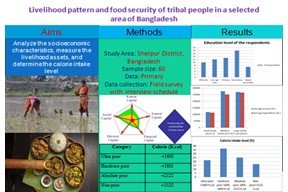Livelihood pattern and food security of tribal people in a selected area of Bangladesh
Abstract
Asset’s possession and food consumption level of tribal people in Bangladesh express their socioeconomic status. The study was conducted to analyze the socioeconomic characteristics, measure the livelihood assets, and determine the calorie intake level of the sample households. Primary data were collected through field survey using an interview schedule from 60 tribal households. Tabular analysis and capital asset pentagon from DFID livelihood framework were used for data analysis. Household consumption data were converted to per person per day calorie intake level. The major findings of the study were that about 41.67% of the respondents were being 15-29 years of age, 30% respondents’ education was in the secondary level, average family size was 5.81, 40% of the respondents were occupied with agriculture as their primary occupation, average annual income and expenditure were Tk. 258560 (US$3015.28) and Tk. 242373.50 (US$2826.51), respectively. The livelihood assets were moderate. About 83.34% of the respondents belonged to the poor category and rest 16.67% of the respondents belonged to non-poor category. About 98.33% and 96.67% respondents suggested that, if job opportunity increases and ensure proper education; then their socioeconomic improvement will be faster. So, government and other organizations need to come forward to create more employment opportunity and education facilities for improving their livelihood pattern and food security status.
Keywords:
Bangladesh, Food security, Livelihood pattern, Tribal peopleDownloads
References
Afsar, M. (2019). Food security status of indigenous people: A case of Chapainawabganj district of Bangladesh. Journal of the EXIM Bank Agricultural University Bangladesh, 1, 109-114.
Ahmmed, M. F. (2006). Aging Situation in Some Selected Tribal Communities in. Dhaka: Institute of Social Welfare and Research, University of Dhaka.
Barkat, A., Hoque, M., Halim, S., & Asmar, O. (2009). Life and Land of Adibashis: land Dispossession and Alienation of Adibashis in the plain district of Bangladesh: Pathaak Shamabesh.
Barman, D. C., & Neo, M. S. (2014). Human Rights Report 2013 on Indigenous Peoples in Bangladesh. Published by Kapaeeng Foundation, Dhaka, Bangladesh.
BBS (2020). Bangladesh Bureau of Statistics, Statistical Year Book of Bangladesh, Ministry of Planning, Government of the People’s Republic of Bangladesh, Dhaka.
Bhuiyan, A. Al-M. (2016). Indigenous Languages in Bangladesh: Loopholes behind the Scene. Indigenous Policy Journal, XXVII (2), 1-17.
Chakma, N., & Maitrot, M. (2016). How ethnic minorities became poor and stay poor in Bangladesh: A qualitative enquiry.
DFID (2000). Sustainable Livelihoods Guidance Sheets. Department for International Development. Available at: http://www.livelihoods.org/info/info_guidanceshessts.html (Accessed on May 30, 2021).
Ismail, A. (2018). How many calories should I eat a day?
Jannat, A., Islam, M. M., Alamgir, M.S., Rafi, D. A. A., & Ahmed, J. U. (2019). Impact assessment of agricultural modernization on sustainable livelihood among tribal and non-tribal farmers in Bangladesh. GeoJournal, 86, 399-415.
Mikkelsen, C. (2014). The Indigenous World. The International Work Group for Indigenous Affairs (IWGIA). Pages: 597.
Mustaree, S. (2010). Effects of micro credit provided by organization for rural development (ORA) on the beneficiaries in some selected areas of Kishoregonj district. An unpublished Master’s Thesis, Department of Agricultural Finance, Bangladesh Agricultural University, Mymensingh.
Nahar, A., Akbar, M. A., Biswas, J. C., Gafur, A., Uddin, M. F., Rashid, S., Mollah, M. A. M., Marma. M. S., Marma, T. M., Marma, A. S. S, Islam, M. K., M. G. Neogi, M. G., & Abdul Hamid, A. (2020). Household Demography and Food Security of Jhum Farmers in Bandarban District, Bangladesh. Journal of Applied Agricultural Economics and Policy Analysis, 3(1), 8-14.
Quader, G. M. (2014). “Indigenous people of Bangladesh.” Anthropology- Bangladesh. Retrieved from http://anthropology bd.blogspot.com/indigenous-people-of-bangladesh.html. Accessed on 17 November, 2021
Rahman, M. A, Paul, S. & Saha, J. K. (2019). Food security and livelihood of tribal people in Bangladesh: The role of microfinance. Journal of Fundamental and Applied Agriculture, 4(3): 881-889.
Rahman, M. A., Siddika, M., & Khan, M.A. (2016). Impact of Credit on Tribal Livelihoods and Food Security in Bangladesh. International Journal of Emerging Issues in Economics, Finance and Banking, 1(1), 1793-1801.
Schaefer, D. (1995). Stop 4: Weimar-Ehringsdorf Travertine quarry. INQUA Conference Berlin 1995. Quaternary field trips in Central Europe. Addendum Excursion 17, SW-Traverse, 1444-1447.
Sikder, M., Baten, M., Ali, M., & Das, P. (2017). Food security status of tribal people at Mohadevpur Upazila in Naogaon District. Journal of Environmental Science and Natural Resources, 10(1), 71–74, https://doi.org/10.3329/jesnr.v10i1.34697
Toppo, A., Rahman, M. R., Ali, M. Y., & Javed, A. (2016). Socio-economic Condition of Plain Land Tribal People in Bangladesh. Social Sciences, 5(4): 58-63.
WFP (2009). World Food Program and Food Security in Bangladesh: Papers presented in the national workshop. Ministry of Food and Disaster management, Government of the People’s Republic of Bangladesh and World Food Program (WFP), Bangladesh.

Published
How to Cite
Issue
Section
Copyright (c) 2021 Agriculture and Environmental Science Academy

This work is licensed under a Creative Commons Attribution-NonCommercial 4.0 International License.

